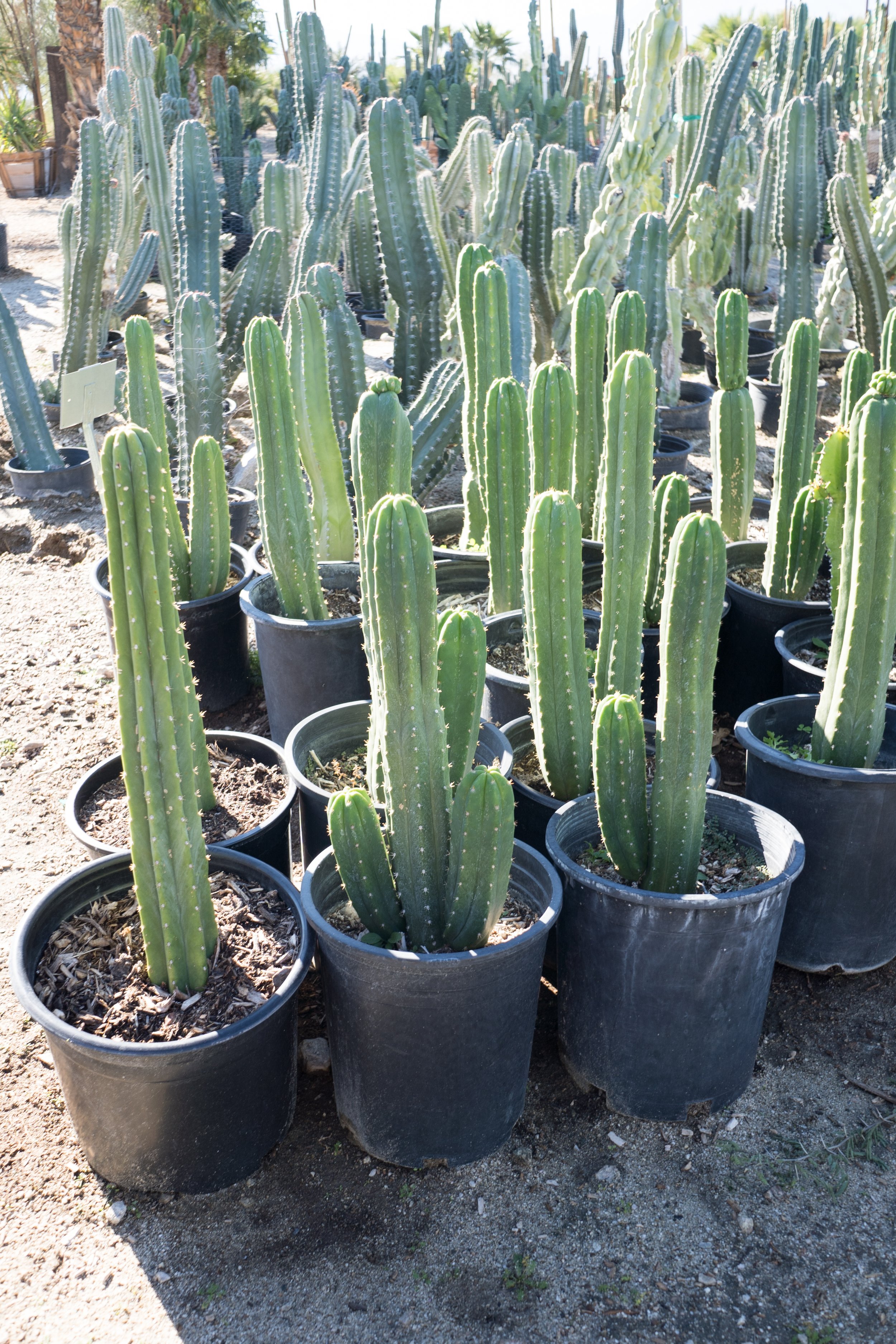San Pedro Cactus
A plant prized by the indigenous people of the Andes mountains for thousands of years, San Pedro Cactus has recently gained popularity in Southwestern-themed gardens in the US.
Charming and cheerful-looking while growing tall and thin, San Pedro draws a sense of awe once it reaches a towering height. Exquisite blooms. Large, showy flowers are quite dramatic and fill the air with perfume.
Finally, this plant is very easy to take care of in warm and temperate climates as well as indoors given enough light. San Pedro is from the Andes at high altitudes and is used to a wide variance in temperature and rainfall.
Botanical name: Echinopsis pachanoi
Other names: Trichocereus pachanoi, Pachanoi, Huachuma
San Pedro Cactus for sale at our nursery in 5-gallon containers
TABLE OF CONTENTS
San Pedro Cactus Appearance
San Pedro is a columnar cactus that grows tall and straight. Tidy and neat appearance.
Typically grows to 10-15 feet tall outdoors in Southern California. On rare occasions, San Pedro will turn into a small tree, measuring twice as high. When they’re this mature, there will be curvier stems.
Cactus stems can be dark green, pale green, blue-green, or yellow-green depending on age and sunlight. Each cactus stem is typically 2-6 inches thick and has 4-8 ribs with short spines.
Very showy and large white flowers appear towards the top of the stems. Blooms start at night and are very fragrant, lasting 1-2 days. Multiple established San Pedro plants will put on quite a spectacle when their flowers bloom together.
Dark green fruits will appear thereafter.
San Pedro Cactus Landscaping Tips
San Pedro is a great candidate for adding vertical interest in the landscape and inside the home.
It has a tidy appearance, growing relatively straight and tidy with minimal arms growing from the side; minimal maintenance is required for many years.
The spines are short, and not as numerous compared to other vertical cacti, so you can enjoy them in areas close to high foot traffic.
San Pedro stems will grow pups from the side and create nice visual interest with staggered heights, whether the cacti are planted along a wall or used as a main focal point.
Very fast-growing, San Pedro will grow a foot taller each year given ideal conditions.
Very undemanding cactus that is suitable for beginners. Can handle a wide range of temperatures and water compared to the average cactus.
The blooms will attract a lot of attention from pollinators and onlookers alike. Gorgeous, large, white flowers have a strong, sweet scent.
San Pedro Cactus Origin
San Pedro Cactus is native to the Andes Mountains, in areas that experience widely varying levels of rain and temperature
San Pedro Cactus Care
San Pedro Cactus is very beginner-friendly in warm regions. Not too sensitive to watering compared to most cacti.
Soil: Loose, well-draining soil that is somewhat fertile.
Temperature: Can withstand temperatures down to 10+ degrees for a short period of time.
Water: Occasional, deep watering. Allow the soil to completely dry out between waterings. Either use a moisture meter or stick your finger through the soil to gauge the moisture level. It’s better to err on the side of underwatering than overwatering.
Sun: Full sun. Partial shade in areas that experience extreme heat
Close up look at San Pedro. Notice the small spines.
San Pedro Cactus Problems
Pests: Fungal diseases from root rot, dry rot, and harsh weather conditions. Pests include scales and spider mites.
To remove scales, pick them off or use horticultural oil or insecticidal soap. Horticultural oil will kill both crawlers and adults with direct contact. Insecticidal soap is better used to target only the crawlers.
For spider mites, control the infestation as soon as it’s discovered. Some options are horticultural oil applied several days apart as well as insecticidal soap combined with hydrogen peroxide.
Whenever using any kind of pesticide, be aware that it can damage the plant if the temperatures are in the 80s or above.
Signs of overwatering: Drooping, squishy texture (especially at the bottom of the cactus)
Signs of too little water: Shriveling, drying skin
Signs of too much sun: Burning, scarring, yellowing
Signs of too little sun: Etiolation, discoloring
San Pedro Cactus Propagation
The easiest way to propagate the San Pedro cactus is by transplanting the offsets that can grow from the base.
You can also collect seeds from the fruits.
FAQ
San Pedro for sale in a 15-gallon container
How much does San Pedro Cactus cost?
At our nursery, San Pedro costs $15 for a 1-gallon container, $45 for a 5-gallon container, $120 for a 15-gallon container, and $350 for a 24" box.
Prices are subject to change. Please contact us for the most up-to-date pricing information. We may have larger sizes available. We provide installation services locally at a separate cost.
Is it legal to purchase San Pedro Cactus?
Although San Pedro has psychoactive properties, purchasing it for ornamental purposes in the US is legal. Please check the laws of your own region if you are not based in the US.
Does san pedro cactus flower?
Yes, and when in bloom, very showy and large white flowers appear towards the top of the stems. Blooms start at night and are very fragrant, lasting 1-2 days. Multiple established San Pedro plants will put on quite a spectacle when their flowers bloom together.
How fast does San Pedro cactus grow?
San Pedro will grow about a foot taller each year given favorable conditions.
SUMMARY
| SIZE (H X W) | 15 feet |
|---|---|
| FLOWER COLOR | White |
| FLOWER SEASON | Spring |
| EXPOSURE | Full Sun to Partial Shade |
| WATER | Low |
| GROWTH RATE | Fast |
| HARDINESS | 10º F, USDA Zone 8 |
| PRUNING | None |


